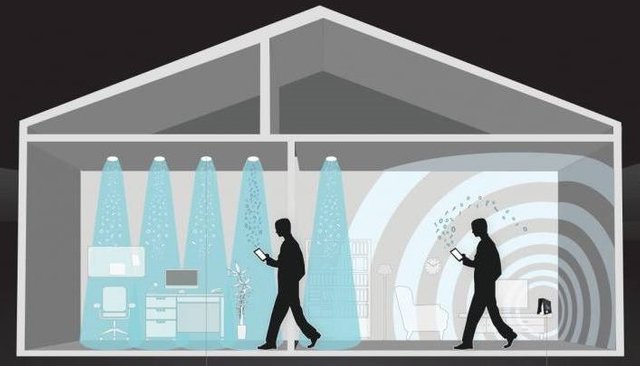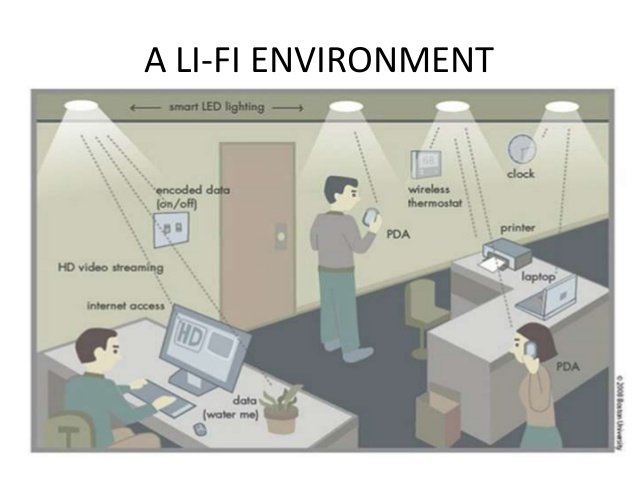li-fi INTERNET THROUGH LIGHT
Chinese researchers at the Institute of Technical Physics in Shanghai have managed to transmit remote information from the internet through light instead of the traditional use of radio waves (wifi). Using a one-watt LED light, the team got four computers to connect to the internet. This small bulb can achieve data flows up to 100 times faster than the speed of the WiFI. This new technology is already known as LIFI.
Do you know of any other wireless network than Wi-Fi? Well, today we will talk about the LI-FI or LIFI concept, a concept that will give much to talk about, the new era of wireless connections, an alternative to the well-known Wi-Fi. We'll explain what Li-Fi is, how it works, what advantages and disadvantages it has with respect to WiFi and the future that awaits this promising term. We will explain everything in a simple way so that you understand it well.

What is LI-FI?
Li-Fi refers to the term Light Fidelity in English, or what would be the same in English Fidelity of Light, is communication by visible light, yes, visible light. This light what it does is transmit ultra-fast data of light that is received by an optical router.
It is a wireless communication system just like Wi-Fi but using as medium visible light instead of electromagnetic waves. Surely you know that the light travels incredibly fast, can you imagine connecting to the internet and navigating with such speed? But…
HOW DO LI-FI TECHNOLOGY WORK?
Li-Fi means communication through impulses of visible light through which information is transferred, that is, transmitting information through light.
Let's see how this new technology works:

In order to enjoy this technology we have in the image a bulb that has an emitting chip or mini transmitting antenna (similar to the one used by traditional routers for wifi) that turns it into a luminous router and so that bulb is capable of emitting waves Li-Fi that will be captured by the light receivers such as mobile phones, cameras, televisions, computers or even other smart appliances. The light waves or impulses emitted by the bulb are only emitted when the bulb is on and are imperceptible to the human eye.
Logically it is essential to have an internet connection so that the antenna of the light bulb transmits the information to the rest of the receivers of a house or office.
The good thing about this technology is that the infrastructure for LiFi technology already exists. There are thousands of lights everywhere, estimated to be 14 billion.
All we need to do is fit a small microchip to each lighting device (LED bulb). Then combine two basic functions: lighting and wireless data transmission.
The founder of this technology explains its operation:
"When a constant current is applied to a [emitter-diode] LED bulb, a constant flux of photons are emitted from the lamp which is observed as visible light. If the current is varied gradually, the output current of the Due to the fact that LED bulbs are semiconductor devices, the current, and therefore the optical output, can be modulated at extremely high speeds that can be detected by a photodetector device and transformed from New in electric current The modulation of the intensity is imperceptible to the human eye, and therefore the communication is as transparent as RF [RF technology] Using this technique, high-speed information can be transmitted from an LED bulb To a receiver ".
.jpg)
A little of history
The term Visible Light Communication implies the use of any portion of light of electromagnetic spectrum to transmit information and it is in the year 2010 when the physicist Harald Haas of the University of Edinburgh (United Kingdom) founded the project D-Light. In the year 2011 began to promote this technology to be able to market it. At the end of 2011 different groups and companies of this industry formed in Li-Fi Consortium in order to publicize and promote this technology.
During the presentation of the new form of transmission, Harald Haas demonstrated his LiFi technology using a light bulb of only 3 $ LED. "It's data through lighting," Haas said. "Transmitting data using an LED bulb is free, not to mention LED bulbs, which in and of themselves are extremely efficient."
ADVANTAGES AND DISADVANTAGES. WI-FI vs LI-FI
Although the LiFi technology is still undergoing experimentation, it is worth mentioning that it promises to be the wireless network of the near future and will replace the known Wi-Fi wireless system over time. Let's see why and what are the advantages and disadvantages of Li-Fi technology.

ADVANTAGES LI-FI vs WI-FI
It can offer speeds of 500 mbps (megabits per second), that is, almost 10 times faster than the optical fiber used by Wi-Fi.
It's cheaper than Wi-Fi, said to be up to 10 times cheaper.
Any light bulb or lamp can be converted into a hotspot or light router cheaply and simply by putting a simple Li-Fi emitter.
Light, not crossing walls, is much safer than Wi-Fi. It can be used in places that are very concerned about security, such as banks.
Does not require the quoted radio frequencies required by Wi-Fi. Radiofrequency communication requires complex radio circuits, antennas and receivers, while Li-Fi is much simpler and uses direct modulation methods similar to those used in low-cost infrared communications devices such as remote controls .
Absence of cables.
Electric light does not disturb or interfere with communication, it does not cause interference with other systems.
It does not saturate the frequency bands used for the transmission of information via Wi-Fi.
It is more energy efficient than Wi-Fi
DISADVANTAGES LI-FI vs WI-FI
It does not work under direct sunlight.
It does not cross partitions or walls.
It does not work with the light off which can give rise to an increase in your light rate.
Only works with devices (tablets, mobiles, etc.) that have a receiver for such technology, that is, have a receiver capable of decoding the light signal.
FUTURE OF LI-FI
As research progresses in this field we can almost say that this technology can replace Wi-Fi without any doubt. This technology is in the experimental phase but we are almost sure how fast everything goes, faster than the light itself, we will not miss anything that in a few years can change forever the way we connect to the internet in our homes. It would not hurt to leave our mobile under a single lamp while it is charging, or while we are browsing without having problems of connectivity as happens many times with Wi-Fi. Everything will be seen in time ... but we throw a question in the air ...
Will we see ourselves in a short time connected to the Internet by means of simple "bulbs"?
Hi! I am a robot. I just upvoted you! I found similar content that readers might be interested in:
https://www.futurescope.co/lifi-technology/
Not indicating that the content you copy/paste is not your original work could be seen as plagiarism.
Some tips to share content and add value:
Repeated plagiarized posts are considered spam. Spam is discouraged by the community, and may result in action from the cheetah bot.
Creative Commons: If you are posting content under a Creative Commons license, please attribute and link according to the specific license. If you are posting content under CC0 or Public Domain please consider noting that at the end of your post.
If you are actually the original author, please do reply to let us know!
Thank You!